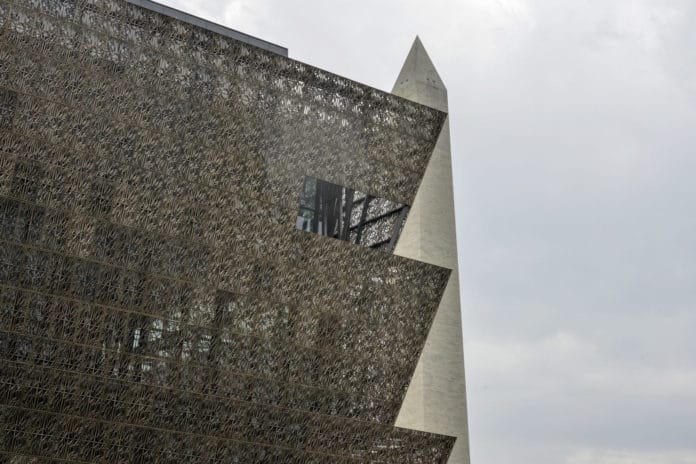WASHINGTON – A dream for 100 years, the National Museum of African American History and Culture promises to become an instant favorite when it opens Sept. 24, its soaring spaces and magical views of the National Mall a fitting setting for its tale of African-American history and achievement.
Museum officials on Tuesday offered a sneak peek at the 400,000-square-foot museum, the 19th of the Smithsonian Institution, that’s next to the Washington Monument. President Barack Obama is expected to cut the ribbon on the dramatic space, which features layers of galleries focused on slavery, segregation and the civil rights movement as well as music, entertainment, sports and politics.
Dozens of hard-hatted workers crammed the fourth-floor cultural galleries, where circular exhibition cases are being filled with objects related to food, education and sports.
“End of Phase One today; that’s like Mile 22 on our marathon,” said Collections Manager Gina Whiteman, adding that there are 12 phases in the installation plan. “This is a long time coming. It’s exciting to see it go from paper to 3-D.”
There is much to be done in the coming months. Wires still hang from the ceiling, and crates of artifacts are parked in every corner of the galleries. Display cases are being built on lower levels, while in the music galleries, cases labeled Bo Diddley, Little Richard and the Jackson 5 await their treasures.
Museum staffers must install 3,000 artifacts – as well as accompanying videos, photos and wall text – that will be on view in 11 inaugural exhibitions. Staff must be moved in, the 400-seat cafeteria brought on line and metal detectors must be installed at the two entrances.
But progress is on track, says Charles Yetter, a senior project manager with construction consultant McKissack & McKissack who has been working on the building for six years. The Oprah Winfrey Theater, a stunning 350-seat space with echoes of the building’s bronze exterior, appears to be complete, but other spaces are definitely works in progress. Officials are deciding on the quotes to be included in the Contemplative Court, for example, a room off the history galleries that includes a dramatic skylight and a waterfall.
Yetter can imagine the room’s power. “It will be aglow,” he said, noting that the walls are glass and copper. “You’ve seen all the bad and some of the good, and you can come here and think about what you saw.”
The architects, curators and designers worked collaboratively to create the museum’s inspiring interior. “What we wanted was spaces with a lot of dramatic viewpoints,” said exhibition designer Ralph Appelbaum.
The familiar bronze-clad structure on Constitution Avenue represents only about a third of the museum’s total space, Yetter said. After entering the central court, visitors will be encouraged to take an elevator 40 feet underground, where the journey begins with the global slave trade. A series of ramps will take visitors through time and space, through slavery, segregation and the civil rights era.
Most of the displays are still off-site, but several large items are in place, although many are wrapped in plastic: the weathered wood cabin used during the period of slavery at Point of Pines Plantation on Edisto Island, South Carolina; a log cabin of free slaves from Poolesville, Maryland; a menacing prison guard tower; a segregation-era railway car.
An airplane used by Tuskegee Airmen hangs above the last ramp, which ascends to a platform with a quote from poet Langston Hughes: “I, too, am America.”
The building’s upper levels offer views of the Mall and the Washington Monument, an intentional nod to its historic home. “The designers want to tie the museum to the city,” Yetter said.
After years of false starts, a bill from Rep. John Lewis, D-Ga., to create the museum passed Congress in 2003 and became law with the pen of President George W. Bush. Three years later, the Smithsonian’s Board of Regents approved the five-acre site on the Mall between the Washington Monument and the National Museum of American History. Lead designer David Adjaye and Freelon Adjaye Bond/SmithGroup were selected in 2009, and construction began in 2012.
The $540 million project was funded through a partnership with Congress, which provided half the money, or $270 million. The other half is being raised through private contributions; officials are within a few million dollars of that goal.
“It’s going to be dramatic,” says Yetter, stopping at the top of a ramp.
It already is.
—
Philip Kennicott contributed to this report.
—
Video: With four months to go before its grand opening, step inside the National Museum of African American History and Culture as the galleries start to take form. (By McKenna Ewen / The Washington Post)
URL:
http://wapo.st/1Xkj6Pv
Embed code:






